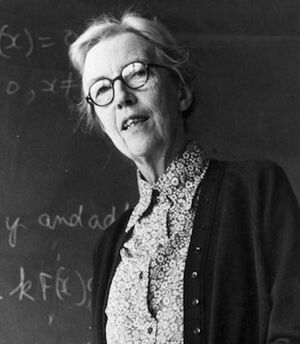Mary Cartwright (nonfiction): Difference between revisions
No edit summary |
No edit summary |
||
| Line 14: | Line 14: | ||
<gallery> | <gallery> | ||
File:Mary_Cartwright_-_Wikipedia.png|link=Mary Cartwright (nonfiction)|[[Mary Cartwright (nonfiction)|Mary Cartwright]] - Wikipedia page screenshot. | |||
</gallery> | </gallery> | ||
| Line 21: | Line 22: | ||
* [[Gnomon algorithm]] | * [[Gnomon algorithm]] | ||
* [[Gnomon Chronicles]] | * [[Gnomon Chronicles]] | ||
== Nonfiction cross-reference == | == Nonfiction cross-reference == | ||
* [[Chaos theory (nonfiction)]] | |||
* [[Mathematics (nonfiction)]] | * [[Mathematics (nonfiction)]] | ||
| Line 30: | Line 33: | ||
[[Category:Nonfiction (nonfiction)]] | [[Category:Nonfiction (nonfiction)]] | ||
[[Category:Chaos theory (nonfiction)]] | |||
[[Category:Mathematicians (nonfiction)]] | [[Category:Mathematicians (nonfiction)]] | ||
[[Category:People (nonfiction)]] | [[Category:People (nonfiction)]] | ||
Latest revision as of 04:59, 18 December 2020
Dame Mary Lucy Cartwright DBE FRSE FRS (17 December 1900 – 3 April 1998) was a British mathematician.
With J. E. Littlewood she was the first to analyze a dynamical system with chaos.
In 1936, Cartwright became director of studies in mathematics at Girton College, and in 1938 she began work on a new project which had a major impact on the direction of her research. The Radio Research Board of the Department of Scientific and Industrial Research produced a memorandum regarding certain differential equations which came out of modeling radio and radar work. They asked the London Mathematical Society if they could help find a mathematician who could work on these problems and Cartwright became interested in this memorandum. The dynamics lying behind the problems were unfamiliar to Cartwright so she approached Littlewood for help with this aspect. They began to collaborate studying the equations. Littlewood wrote:
For something to do we went on and on at the thing with no earthly prospect of "results"; suddenly the whole vista of the dramatic fine structure of solutions stared us in the face.
The fine structure which Littlewood describes here is today seen to be a typical instance of the butterfly effect. The collaboration led to important results, and these have greatly influenced the direction that the modern theory of dynamical systems has taken.
In 1945, she simplified Hermite's elementary proof of the irrationality of π. Her version of the proof was published in an appendix to Sir Harold Jeffreys' book Scientific Inference. In 1947, she was elected to be a Fellow of the Royal Society and, although she was not the first woman to be elected to that Society, she was the first female mathematician.
In the News
Mary Cartwright - Wikipedia page screenshot.
Fiction cross-reference
- Did you step on a butterfly in Texas during a tornado while watching Jurassic Park in Brazil under the influence of JJ-180?
- Gnomon algorithm
- Gnomon Chronicles
Nonfiction cross-reference
External links
- Mary Cartwright @ Wikipedia

